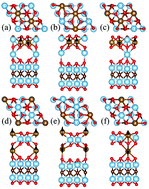Enhanced stability and stacking dependent magnetic/electronic properties of 2D monolayer FeTiO3 on a Ti2CO2 substrate†
Abstract
A 2D FeTiO3 magnetic monolayer which was recently exfoliated from non-van der Waals layered bulk crystals has opened the research era of low-dimensional magnets, however its structural and chemical instability hampered its practical application. Through first-principles calculations, we found that the stability of 2D FeTiO3 can be obviously enhanced by a monolayer Ti2CO2 substrate and simultaneously the magnetic/electronic properties can be well regulated. Depending on the FeTiO3/Ti2CO2 stacking configurations, the system exhibits different magnetic and electronic behaviors, which can be either ferromagnetic or antiferromagnetic with the feature of half-metallic (with 100% spin-polarization ratio) or metallic. Moreover, it was also found that the interfacial magnetic coupling orders can be precisely modulated with an external electric field (−0.4 to 0.2 V Å−1). In particular, the Curie temperature is predicted to be 315 K, rendering the magnetism stable at room temperature. These interesting properties make 2D FeTiO3/Ti2CO2 a promising candidate material for spintronic device applications.



 Please wait while we load your content...
Please wait while we load your content...